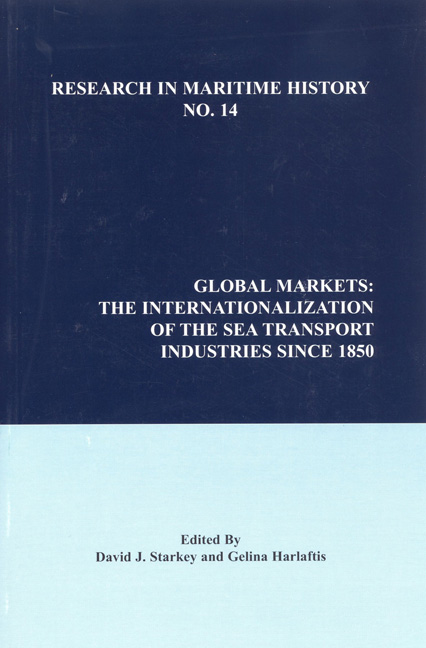Book contents
- Frontmatter
- Contents
- About the Editors
- Contributors
- Introduction
- “International Freight Markets in the 1830s and 1840s: The Experience of a Major Finnish Shipowner”
- “The First (and Very Secret) International Steamship Cartel, 1850-1856”
- “Competition or Co-operation in the Global Shipping Industry: The Origins and Impact of the Conference System for British Shipowners before 1914”
- “National Alliances and Global Webs: The Internationalization of Japanese Shipping”
- “Dutch Sea Transport in Transition: The German Hinterland as Catalyst, 1850-1914”
- “The Expansion of American Interests in Transatlantic Commerce and Trade, 1865-1893”
- “The Expansion of Japan's Shipping Interests before the Sino-Japanese War”
- “Cooperation and Reorganization on the North-South Routes from Japan in the Interwar Period”
- “The Global Communications Industry and Its Impact on International Shipping before 1914”
- “The Nineteenth-Century Roots of Globalization: Some Technological Considerations”
- “The Global Fish Market: Internationalization and Globalization, 1880-1997”
- “Convergence or National Styles? The Japanese Challenge to the British-Norwegian Hegemony in the Twentieth-Century Whaling Industry”
- “International Trends and Greek Shipping: The Business Strategy of Demetrios Moraitis, 1893-1908”
- “Organizational and Managerial Patterns of Greek- Owned Shipping Enterprises and the Internationalization Process from the Internar Period to 1990”
- “Internationalization and the Collapse of British Shipbuilding, 1945-1973”
- “Globalization and International Competitiveness: The Experience of the Japanese Shipping Industry since the 1960s”
- “Containerization and the Globalization of Liner Shipping“
“Cooperation and Reorganization on the North-South Routes from Japan in the Interwar Period”
- Frontmatter
- Contents
- About the Editors
- Contributors
- Introduction
- “International Freight Markets in the 1830s and 1840s: The Experience of a Major Finnish Shipowner”
- “The First (and Very Secret) International Steamship Cartel, 1850-1856”
- “Competition or Co-operation in the Global Shipping Industry: The Origins and Impact of the Conference System for British Shipowners before 1914”
- “National Alliances and Global Webs: The Internationalization of Japanese Shipping”
- “Dutch Sea Transport in Transition: The German Hinterland as Catalyst, 1850-1914”
- “The Expansion of American Interests in Transatlantic Commerce and Trade, 1865-1893”
- “The Expansion of Japan's Shipping Interests before the Sino-Japanese War”
- “Cooperation and Reorganization on the North-South Routes from Japan in the Interwar Period”
- “The Global Communications Industry and Its Impact on International Shipping before 1914”
- “The Nineteenth-Century Roots of Globalization: Some Technological Considerations”
- “The Global Fish Market: Internationalization and Globalization, 1880-1997”
- “Convergence or National Styles? The Japanese Challenge to the British-Norwegian Hegemony in the Twentieth-Century Whaling Industry”
- “International Trends and Greek Shipping: The Business Strategy of Demetrios Moraitis, 1893-1908”
- “Organizational and Managerial Patterns of Greek- Owned Shipping Enterprises and the Internationalization Process from the Internar Period to 1990”
- “Internationalization and the Collapse of British Shipbuilding, 1945-1973”
- “Globalization and International Competitiveness: The Experience of the Japanese Shipping Industry since the 1960s”
- “Containerization and the Globalization of Liner Shipping“
Summary
The First World War triggered the reorganization of world shipping. Tonnage owned in Britain and the Commonwealth, as a proportion of world tonnage, declined steadily from forty-five percent in 1914 to thirtyfive percent in 1927, while that of Japan and the US increased rapidly (see table 1). Due to reparations, Germany's ocean-going tonnage had fallen to zero by 1922, but thereafter it made a quick recovery to constitute a factor in world shipping once more. US shipping, on the other hand, was put under the control of the Shipping Board and liberalization was a slow process. Accordingly, Japan, whose tonnage had increased enormously during the war, emerged as the major growth point in the realignment of world shipping during the 1920s. As the volume of laid-up tonnage decreased significantly in 1926-1927, and world trade began to show signs of recovery, new routes were quickly developed, especially by Japanese shipping companies.
The scale of the Japanese economy expanded enormously during the 1914-1918 conflict, with the cotton spinning industry leading the way in terms of exports. Taking advantage of the absence of previously dominant British textiles in areas such as South Asia, Africa, Australia and South America, the Japanese expanded from East Asia into these under-supplied markets at one fell swoop (see table 2). Japanese shipowners first entered the Australian and South Pacific routes when conferences lost control of these trades because of the war. Then, after 1918, the Japanese, in seeking outlets for their surplus tonnage, aggressively developed routes in areas where conferences control was weak or non-existent, most notably in the Pacific, to New Zealand, and the African-South American routes. Moreover, in line with the development of Japan's heavy and chemical industries, South Pacific services were energetically cultivated as supply routes for raw materials such as rubber, tin, iron ore and soda ash. On these routes it was possible to assign ships according to cargo movements uninhibited by conferences, so that Japan was able to import from a wider range of countries. For example, raw cotton was now imported from Brazil, Egypt and Uganda in addition to India and the US, and wool was brought in from Argentina, South Africa and New Zealand as well as from Australia.
- Type
- Chapter
- Information
- Global MarketsThe Internationalization of The Sea Transport Industries Since 1850, pp. 163 - 194Publisher: Liverpool University PressPrint publication year: 1998



